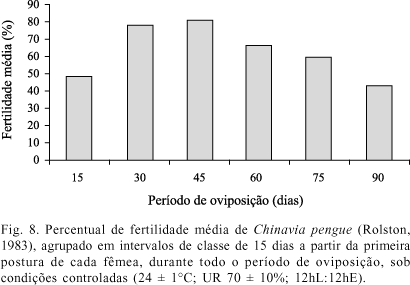Adults of Chinavia pengue (Rolston, 1983) were collected in Garopaba county, SC, and used to establish a laboratory culture under controlled conditions (24 ± 1°C; 70 ± 10% RH; 12hL:12hD). Adults and nymphs were fed with green beans (Phaseolus vulgaris L.). Eggs of C. pengue follow the pattern of coloration, chorion sculpture, color and shape of the aero-micropylar processes described to other neotropical Chinavia species. The first instar has the dorsal macula of the head and thorax characteristic of Chinavia species. In C. pengue, this macula is orange-red, and the abdominal maculae (4+4 lateral maculae and one median) are white. From second to fifth instars diagnostic characteristics are orange-red maculae at pro and mesothorax, and at middle of abdominal lateral plates. There was no overlapping of the head-capsule measurements between the five instars of C. pengue. Each female laid an average of 15.9 ± 4.18 egg masses and 218.8 ± 48.60 eggs; there was a marked peak at 14 eggs per egg mass. Mean egg fertility was 70.0% ± 19.01; mortality in the second to fifth stadium was 1.6% ± 4.49. Sex ratio was 1 male: 1 female. The mean duration of the immature stage (egg to adult) was 45.7 ± 2.99 days.
Developmental time; egg; external morphology; nymph; stink bug








